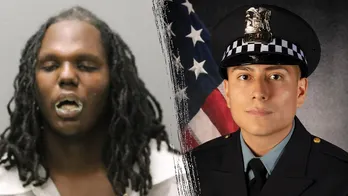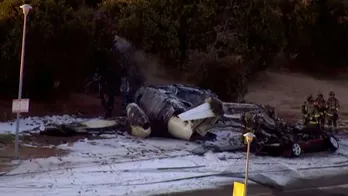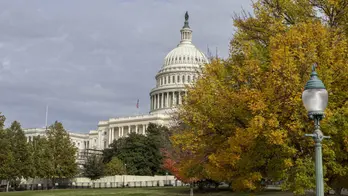Virginia hid execution files from the public. Here's what they don't want you to see
In January, NPR aired excerpts from four tapes recorded behind the scenes during Virginia executions. It was only the second time in history that audio from inside an execution chamber had ever been published. The records revealed details about the last seconds of prisoners' lives and indicated the Virginia Department of Corrections may have tried to cover up one of the state's recent botched executions.
A former employee donated the four tapes and hundreds of other execution documents to the Library of Virginia more than a decade ago. But shortly after NPR aired the audio, something unusual happened. A representative from the Department of Corrections requested that the library give the records back. Within a week, the library complied. The collection is once again behind prison walls.
The tapes can still be heard in full on NPR's website and two of six boxes of materials can be seen at the prison if a request under the public records act is made. But in order for more of the execution history to remain accessible, NPR is now exclusively publishing a selection of the documents that journalists managed to photograph at the library before they became restricted. The records, which detail responsibilities of staff, include candid photos taken of the prisoners before their deaths and even show the keys to Virginia's electric chair, illustrate how executions were conducted in the state that carried out more than any other.
The execution Polaroids
In Virginia, it was someone's job to take Polaroid pictures of condemned prisoners before they were led away to be executed.
The photos left behind reveal a range of emotions. In a series of different shots taken of Wilbert Lee Evans, he scratches his chin, raises his eyes, turns on his side and slumps his shoulders. As Buddy Justus holds a sign showing the identification number he was given when he was first booked into prison, his eyes stare straight into the camera.
The shots appear to have been taken in the same spot. Identical white curtains draped behind the prisoners as they posed, years apart. During the late 1980s and early 1990s, the time frame in which the photographed men were executed, Virginia put people to death shortly before midnight. A black clock in the top right hand corner of nearly all the images seems to confirm that.
In his pre-execution photo, 33-year old Earl Clanton poses with hands on hips and eyebrows raised. Clanton grew up in prison. He was 17 when he was convicted of murdering a neighbor. How he spent most of his time behind bars is unknown. But the files published by NPR detail the last few months of his life, before his execution on April 14, 1988.
The path to execution, memorialized by memos
Before Earl Clanton was put to death on Virginia's electric chair, the documents indicate his sisters, his mother, attorneys and a reporter from Spain came to visit. In between meetings, Clanton tallied up the belongings in his cell. He counted one blue Wrangler jean jacket, a pack of cigarettes and a chess set among them. The prisoner would later bequeath those possessions to one of his lawyers who was defending him for no charge.
It's unclear whether that lawyer was there to watch him die. But police surrounded him when he walked into the death chamber, the files reveal. Behind the scenes, prison staff were also working. A small, handwritten note indicates that a device – likely the electric chair – was turned on by one worker at 11:01 p.m. for over a minute. Shortly after, Clanton was dead. The chief physician at the Department of Corrections signed his name in a log book to certify that Clanton had expired at 11:07 p.m. "by reason of execution."
The state of Virginia doesn't seem to have rushed to deal with his body. An envelope containing Clanton's autopsy report is dated 21 days after he was executed. It appears that only after those three weeks was his family able to take Clanton home. His death certificate shows his body was buried in the Clanton Family Cemetery in Carson, Va., a town 40 miles away from the state penitentiary.
The certificate also reveals something else: Clanton's cause of death was listed as a homicide. This was not unusual in the region. Execution workers told NPR that death certificates in other Southern states also classified executions as homicides. Some of those workers said this caused them to feel like murderers, too.
Review the hidden Virginia execution files
Why Virginia took back the files
Similar legal memos, autopsy reports, court records, death certificates and handwritten notes were left behind regarding five other men that Virginia executed. Sometimes execution files like those are kept secret for security reasons; prison representatives have claimed that details could be used by activists to stop future executions.
But these documents posed little threat. Virginia abolished the death penalty in 2021.
Dale Brumfield referenced some of the now-confidential files to write a book about the state's path to the abolition of capital punishment. He believes rescinding the documents follows Virginia's historic pattern of suppressing information about the death penalty.
"Some of that stuff is very benign," Brumfield said. "So this culture of secrecy, they're just covering up the ugliness of the whole thing."
The Department of Corrections declined NPR's request for an interview. In an emailed statement, a representative said the files contained "sensitive health, security, and personnel information about former inmates, victims, and VADOC employees, which makes them private in nature."
The Library of Virginia also declined a request for an interview to discuss why the agency relinquished the files to Corrections in January. But back when all the documents were still public in December, government records archivist Roger Christman told reporters he believed the library's job was to keep files about events like executions accessible – not hidden.
"That's what this entire building and agency is about," Christman said. "Whether you agree with it or not, this was happening."
Barrie Hardymon edited this story. Monika Evstatieva produced it. Photo editing by Emily Bogle.
Disclaimer: The copyright of this article belongs to the original author. Reposting this article is solely for the purpose of information dissemination and does not constitute any investment advice. If there is any infringement, please contact us immediately. We will make corrections or deletions as necessary. Thank you.







